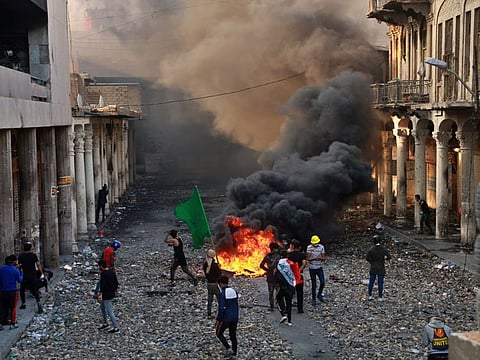Turmoil will continue to roil Middle East in 2020
Iranian designs will continue, while Russia and China move in

As 2019 winds down it will be remembered as the year of mass protests not only in the Arab world but far beyond. For the region a second wave of popular uprisings gripped Iraq, Lebanon, Algeria, Sudan and Iran eliciting comparisons and contrasts to the 2011 Arab Spring, whose reverberations continue to be felt across the troubled region.
But if 2019 was marked by popular protests then 2020 will see a continuation of chaos and political uncertainty in many countries. From Algeria to Iraq people echo the same demands: Social and economic justice under an equitable political system that represents the masses and not the few. In contrast to the 2011 Arab Spring, most recent uprisings have been largely peaceful. And when blood is shed it is due to foreign interference as is the case of Iraq and Lebanon.
Here is a sneak preview of what we expect to see in 2020.
Syria will remain a regional flashpoint as Israel continues to strike Iranian bases there. The US will continue to maintain symbolic presence in the oilfields in the east and there are fears that it may empower a separatist Kurdish entity in that regionOsama Al Sharif
Iraq and Lebanon
The common factor in both countries is Iran’s deliberate intervention in local politics. In Iraq, which has long borders with Iran, people of all sects and ethnicities have become united in their call to end Tehran’s sway over the country’s dysfunctional political system.
Iran will continue to resist efforts to reduce its influence and as it did with its own protests last November it will not hesitate to use force to target activists and protesters.
As in Lebanon, the Iraqis find themselves wedged between two hostile forces; Iran and the United States. Iran is not shy to use its proxies in both countries: Hezbollah in Lebanon and the Popular Mobilisation Forces (PMF) in Iraq. The face-off between the US and Iran will hamper efforts to deliver a political solution in both countries in the short run.
Meanwhile, there are genuine concerns that Lebanon’s economy could collapse at any moment as the political impasse lingers.
Iran and its proxies will derail efforts to deliver what the protesters want: A progressive election law that would lead to early elections allowing citizens in both countries to choose independent and impartial deputies away from a sectarian-based quota system.
Failing to achieve this goal, the likelihood of civil strife becomes greater. A grim outlook for both countries is a more realistic scenario.
Syria
Hopes for an all-Syrian agreement to adopt a new constitution are fading fast. Instead, the regime appears to have received the green light to conquer rebel-held Idlib, leading to a new humanitarian catastrophe. Turkey and Russia seem to have reached a new understanding where Ankara would abandon Idlib while enhancing its military presence in northeastern Syria and pushing back Kurdish forces.
But Syria will remain a regional flashpoint as Israel continues to strike Iranian bases there. The US will continue to maintain symbolic presence in the oilfields in the east and there are fears that it may empower a separatist Kurdish entity in that region. As for the Russians they will continue to engage with the Iranians and the Turks over Syria as they expand their own military presence along the Mediterranean.
Libya
The war-torn country is becoming a major flashpoint following the recent controversial agreement between the National Accord government in Tripoli and Turkey. As the forces of the Libyan national army, led by retired general Khalifa Haftar, continue their advance towards the capital, regional and world powers are divided between supporting the National Consensus Government and backing Haftar’s drive to unite the country. Turkey’s military intervention will complicate the situation further and will polarise the region further.
Israel/Palestine
The deal of the century is now on hold pending the outcome of Israel’s third general elections within a year. But the announcement by the International Criminal Court last week that it would launch an investigation into alleged war crimes by Israel and the Palestinians since 2014, has rattled the Israeli political and military establishments.
This is a new and unprecedented challenge facing Benjamin Netanyahu who has attacked the ICC, calling it anti-Semitic. One immediate result of the ICC move is the recent announcement by Israel that was suspending plans to annex the Jordan Valley — for now.
Meanwhile, deep divisions will continue to plague Palestinians in the West Bank and Gaza. Despite plans to hold legislative elections in 2020, Hamas and Fatah are unlikely to strike an accord. On the other hand, as Netanyahu fights for his political survival — as well as trying to avoid imprisonment on corruption charges — he may well trigger a military confrontation with Hezbollah or Hamas or both.
Tension along Israel’s northern and southern borders remains high. Netanyahu’s worst nightmare is the possibility that the US and Iran may find common ground on the nuclear deal and other issues such as Yemen.
Overall, all indications point to more regional turmoil in 2020. The region will face additional polarisation over Iran, in addition to its intervention in Iraq and Lebanon. And as the regional drawdown by the US continues, we will see increasing influence by Russia and China.
— Osama Al Sharif is a journalist and political commentator based in Amman.
Sign up for the Daily Briefing
Get the latest news and updates straight to your inbox



